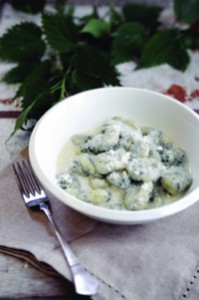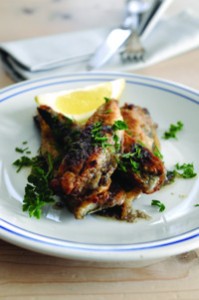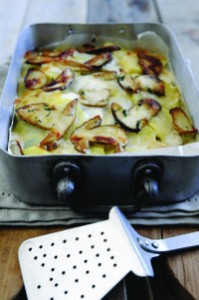Foraging, collecting and hunting for food is part of Italian life ? Mario Matassa shares some Italian recipes from the wild…
Whether it?s chestnuts, borage leaves and mushrooms in the autumn, truffles in the winter, asparagus, wild hops, nettles and dandelions in the spring or wild garlic, berries and fruits in the summer, there?s always something that has Italians taking to the forests, the mountains, the countryside and even their gardens with their baskets. Wild foods in Italy are not niche, they are very much an integral part of the food culture.
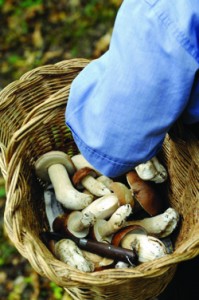 Most Italians, particularly those that live in the provinces, will regularly eat something they?ve collected, hunted or foraged themselves. Most popular are the various foraged foods which are available to everyone if you have a sense for the season, a little knowledge and are prepared to put in a bit of effort. From a very early age Italians are introduced to the tastes of the wild. Parents and grandparents will often spend a day picking berries by the road side or gathering chestnuts in the forest with their children.
Most Italians, particularly those that live in the provinces, will regularly eat something they?ve collected, hunted or foraged themselves. Most popular are the various foraged foods which are available to everyone if you have a sense for the season, a little knowledge and are prepared to put in a bit of effort. From a very early age Italians are introduced to the tastes of the wild. Parents and grandparents will often spend a day picking berries by the road side or gathering chestnuts in the forest with their children.
The repertoire of recipes for foraged foods is as long as that for conventional ones. Where foraged foods differ is that often the window of opportunity is short. Over the years, an entire body of cultural mores and traditions have arisen around foraged foods which govern how they are collected as well as how they are used in the kitchen.
Chestnuts start falling from the trees in late September or early October, depending on the conditions. By the end of October the season is effectively finished. Fresh green walnuts have to be collected at the end of June if you want to make a few bottles of liqueur, and elderflowers blossom for just a few weeks in late spring, if you fancy making fritters. However, if you don?t, not all is lost. The same tree bears its fruit in late July if you want to make some jam.
Of course, Italians that live in the higher altitudes have to adjust their seasonal calendar accordingly.
There is something about wild foods that certainly do differentiate from conventional foods. Of course, there?s the issue of provenance. Foods caught or collected in the wild are considered superior because their provenance cannot be called into question. They?re natural and natural foods are invariably better for you and, for some reason, taste better too. There?s also, of course, the economic issue. Although a licence is required to pick mushrooms and go truffle hunting, wild foods are generally free ? an added bonus that Italians seldom overlook. But more than this,
I think it is the thrill and joy that comes with a day spent in the mountains or in the forest foraging for food ? and the pride and satisfaction of sitting down with family and sharing something you?ve gone that little extra mile to collect and eat.
………………………………….
Nettle gnocchi with Gorgonzola sauce
Gnocchi di ortiche con Gorgonzola
Serves 4 | Preparation 1 hour | Cooking 10 minutes
400g plain flour
1 small egg
Large bunch of young nettle leaves
Salt
150g Gorgonzola cheese
150ml single cream
Freshly grated Parmesan cheese to serve
To make the gnocchi, boil the potatoes in lightly salted water until tender. Pass the potatoes through a ricer and set aside to cool for a few minutes.
Clean the nettles and boil for a few minutes until tender.
Drain the nettles and place in a fine sieve and press down with the back of a spoon to remove as much water as possible. Finely chop the cooked nettles and add to the mashed potatoes with the egg and flour.
Mix everything together well, kneading gently on a floured board.
To shape the gnocchi, roll small pieces of dough into 1cm wide ?snakes? and cut into 1-2cm pieces. Dust with flour and set aside.
To make the sauce, gently heat the cream in a pan and, when it is warm, add the Gorgonzola cheese chopped into small dice. Stir until melted.
To cook the gnocchi, bring a large pan of salted water to the boil and add the gnocchi. Once they float to the top, remove with a slotted spoon. Dress the gnocchi with the sauce and serve with Parmesan cheese.
………………………………….
Crispy semolina-crusted wild trout fillets
Filetti di trota con crosta crocante
Serves 4 | Preparation 15 minutes | Cooking 10 minutes
6 tbsp semolina
Olive oil for frying
50g unsalted butter
? tsp anchovy paste
1 tbsp parsley, finely chopped
Salt and black pepper
Prepare the trout fillets by running a knife gently over the skin to descale them under running water. Remove the head and make a slit down the centre of the fish to remove the insides. Once clean, gently press the fillets to open them out into a butterfly. You should be able to remove the backbone in one go by firmly pulling it from the top of the fish to the tail. Check for any stray bones and then set aside until needed. (Alternatively you could ask your fishmonger to do this step for you.)
Mix the flour with a little salt and pepper onto a plate. Place each fillet onto the seasoned flour and press down gently on both sides. Ensure that the fish is coated evenly in flour. Pour the oil into a large frying pan and heat. When hot, add the trout fillets skin side down and cook for 2-3 minutes, depending on the thickness of the fillet. You may need to press the fillet down with the back of a fish slice to stop it curling in the pan.
Flip the fillets over and cook for a further 2 minutes. Remove from the pan and keep warm. Add the anchovy paste to the pan and the butter. Stir until the butter is melted and the anchovy paste has combined. Pour over the fish fillets and serve immediately with lemon wedges.
………………………………….
Pan fried dandelion leaves with olives and garlic
Erbette saltati in padella con olive e aglio
Serves 4? | Preparation 15 minutes? | Cooking 15 minutes
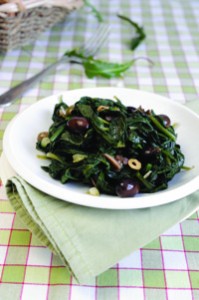 Large basketful of young dandelion leaves
Large basketful of young dandelion leaves
4 tbsp of olive oil
2 garlic cloves
100g black olives
Fresh or dried chilli, to taste
Salt and pepper
Rinse the greens under running water to remove any grit or mud. Bring a large pot of salted water to the boil. Once boiling add the greens and blanche for a couple of minutes. Drain and set the greens aside. Place the oil and the garlic cloves in a large frying pan and heat. Allow the garlic to cook in the oil for 1-2 minutes. If you are using a fresh chilli, add this and allow to soften slightly. Add the dandelion leaves and cook gently for 4-5 minutes. If using chilli flakes, add these and stir. Taste for seasoning and serve.
TIP If you are unable to get dandelion leaves for this recipe you can also use kale or cavolo nero (black kale) as an alternative. Follow the method given above but boil the greens for about 8-10 minutes.
………………………………….
Gratin of porcini mushrooms and potatoes with cream
Funghi porcini e patate gratinate al forno
Serves 4 | Preparation 25 minutes | Cooking 40-50 minutes
200g fresh porcini mushrooms
Olive oil
1 tbsp finely chopped parsley
1 clove of garlic
50g butter
250ml single cream
Salt and pepper
Peel the potatoes and slice into ?cm slices. Place the potato in a large pan of water until needed. To prepare the porcini mushrooms, gently brush off any mud or sand and slice into ?cm slices. Place a few tablespoons of olive oil in a large frying pan and add the crushed garlic clove. Add the mushrooms and fry until golden. Remove from the heat and sprinkle over the chopped parsley.
To assemble the dish, place a layer of sliced potatoes in a greased baking dish and on top add a layer of porcini mushrooms, continue until all the mushrooms and potatoes have been used, adding of small knob of butter and seasoning to each layer. Pour over the cream and bake in a preheated oven at 180?C/350?F/Gas Mark 4 for 40-45 minutes, or until the potatoes are cooked.

